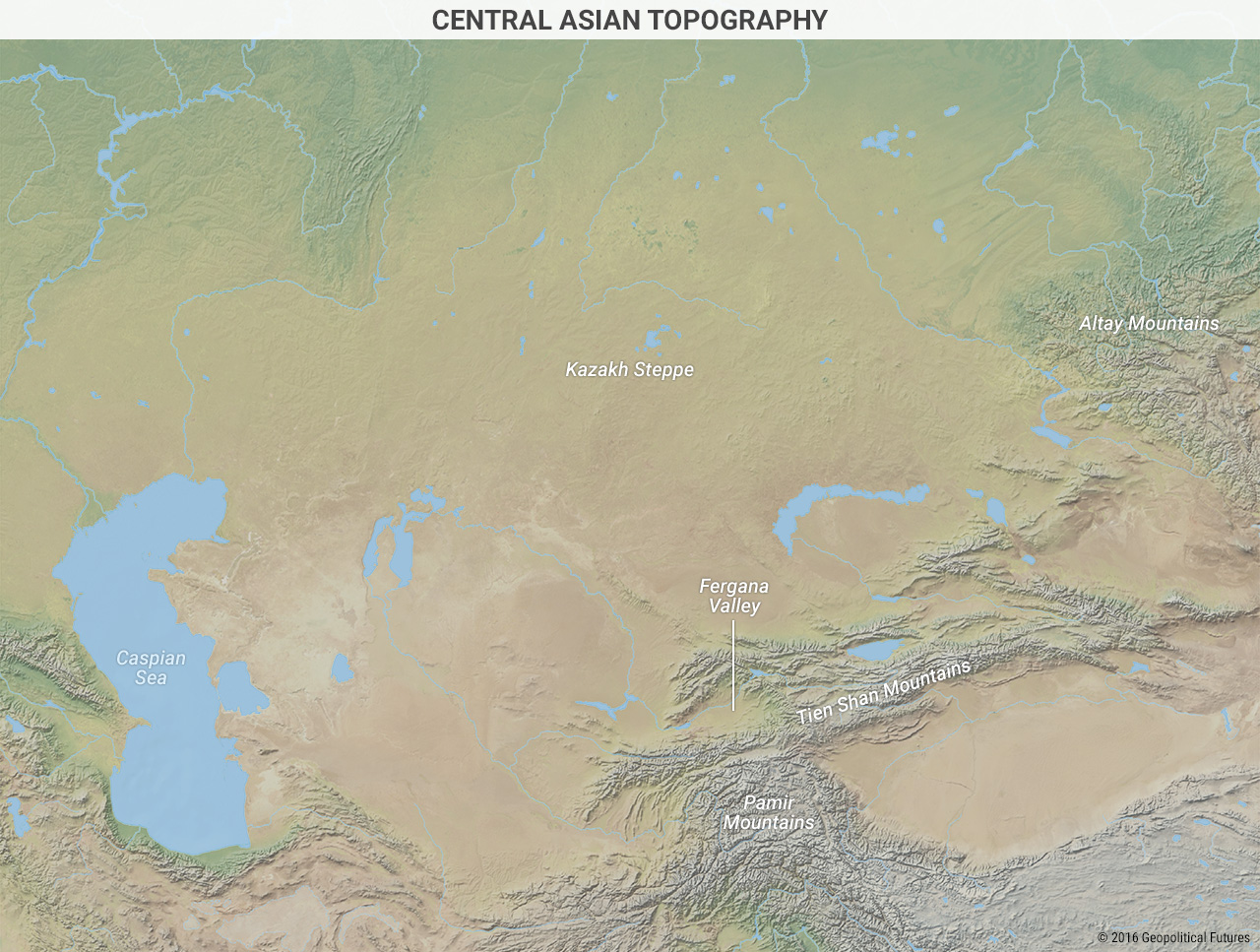Xander Snyder: Hi and welcome to the Geopolitical Futures podcast. I’m Xander Snyder and today I am joined by Allison Fedirka. How are you Allison?
Allison Fedirka: I’m good Xander, how are you?
XS: Doing great. We’re going to talk about a region today that a lot of people don’t always focus on but it’s actually a fairly important part of the world and that is Central Asia. We’ll talk about, first off just where it is, which countries have an interest in it and why we at GPF are focusing on it? So Allison maybe just first off we can start with some geography. Where is Central Asia and where does it sit in the middle of, which regions?
AF: Right, so I apologize in advance for anyone that we don’t have the capabilities to share a map with you. I know that some of our listeners have expressed an interest in that capability and we are still working on it. But if you are listening and have internet access, I would suggest quickly Googling a map of Central Asia and you’ll have what I like to call the ‘stans come up, we’ve got Kazakhstan, Uzbekistan, Turkmenistan, Tajikistan and Kyrgyzstan.
And basically, this area was also part of the former Soviet Union. So when we’re talking about these countries, we’re talking about former Soviet states, countries that we’re up until 1991 part of the Soviet Union, strongly under Russian influence, countries that we’re carved out when the Soviet Union fell. And so that’s important to keep in mind in terms of the lifetime that these current nation state borders have seen.
And the countries that we’re talking about, you’re thinking about the south of Russia, west of China, wedged in between the Caspian Sea and China and then on the south you’ve got Iran, Pakistan, Afghanistan and India so it’s this little circle where you can see the intersection of China coming in. On its western border, we’ve got Iran who if they go up onto their northern border will enter into Kazakhstan, to Turkmenistan and into this region. And then you have Russia where if they go further south on multiple fronts they will enter into Kazakhstan.
So this is the region of the world that we’re talking about and it has a proximity to three very key regions that I am sure all of you are familiar with, which are Russia, China and the Middle East. And so this is one of the reasons why this region in particular is interesting because of its positioning.
XS: So as you mentioned Allison, given the history of Central Asia and it formerly being a part of the Soviet Union, maybe it makes sense to start with Russia’s interest in the region. We’ll use that as a jumping off point to go kind of around the circle.
So for starters, no country likes to give up territory and Central Asia was formerly a part of the Soviet Union. So Russia’s maintained a very unique relationship with Central Asia. And there’s also the issue of Russia’s general strategy of maintaining as much buffer space as it possibly can between it and other areas of the world. This is certainly the case in Europe on the great European plain. Russia’s a very big, flat territory that’s easy to move into so it likes to maintain some space between it and other areas. There are quite a lot of natural resources within Central Asia. It’s a fairly big producer and it depends by country not all countries produce the same amount of oil and hydrocarbons as others. Turkmenistan for example is a pretty big exporter being right on the Caspian and it actually depends on exports more with China but we’ll come to that in a little bit. So there’s that interest.
And it also just has some peripheral military bases sort of left over from that Soviet period. So for example in Kyrgyzstan, there’s a lake called I’m probably, almost certainly going to mispronounce this, but Issyk-Kul where last I looked Russia still has a submarine torpedo testing base there. It’s a very deep lake so it makes sense to do it there.
Now that’s sort of like a grand strategy if you think about it in terms of territorial buffers and all that. But then there’s also the issue that isn’t always focused on, which is Russia has a very large Muslim population. And so it’s always somewhat focused on, the threat that could from radical Jihadism to the extent that activities in the Middle East potentially could spill over back into Russia.
And of course, just south of Central Asia, is essentially the Middle East. Iran borders Turkmenistan to the southwest, Afghanistan shifts to the south of Turkmenistan and Tajikistan. So this is really the area that sits between Russia and a place where more radical philosophies could potentially drift up into the north to Russia.
AF: That’s an excellent point Xander and I would also just add that the countries that we’re talking about in Central Asia also have large Muslim populations themselves, which has made them in the past very attractive grounds for recruitment. You’ve seen lots of Central Asian fighters go into the Middle East to fight with ISIS and other groups.
And so it’s a real threat not just in terms of physical boundaries of former fighters coming up into Russia are presenting threats to Russia on that front. But also just that it’s seen as a very attractive recruitment ground and breeding ground for the type of extremist behavior that you’re talking about and which would present a threat to Russia and to other countries, even these countries themselves who could potentially be victims of attacks or other types of behavior.
And one thing we can do is just kind of explain why it’s so attractive as a recruitment ground is a lot of this also has to do with some of the economic problems that these countries are currently facing. And I think Xander, you kind of hinted at some of the root problems that might happen with the natural resource deposits that are in these countries and how that could be a problem for the countries economies at this point in time.
XS: Sure well as GPF has done quite a bit of research on oil generally, this applies to different parts of the world and Central Asia is one of those, which is global energy prices are very low right now. So any country that is overly dependent the production of oil or natural gas or at least has become dependent, is going to face this risk with very low oil prices of not really being able to make ends meet. And this is certainly the case for many Central Asian countries, again not all are created equal. And whenever you have the risk posed by economic uncertainty, you can’t look at that in isolation. You also need to consider the political ramifications that come with that economic threat.
So for example when you think about the relative youth of all these Central Asian nations because once again, they all came about because of an outgrowth of the Soviet Union, they’re all very young. And a lot of the leaders that have essentially been in power in these countries for the last thirty years were former members of the Communist party of the Soviet Union.
So the largest country in Central Asia, Kazakhstan, which is really taking on an increasing leadership role in the region, has been lead by a guy named Nazarbayev for the last well thirty years since the fall of the Soviet Union. He’s very old now. I think he’s 77 or 78 years old. And I think the question that is on everyone’s mind right now is when these dictators who’ve essentially maintained stability in these countries with really some form of an iron fist over the last several decades, when they die, what comes after that?
And right now, in Uzbekistan which borders Kazakhstan to the south, they’re actually going through a political transition without too much turmoil. So their former leader passed and someone has replaced them and they haven’t really erupted into any sort of mass instability yet, but there’s a consolidation going on right now. But Uzbekistan is not really as large or powerful as Kazakhstan and Kazakhstan sits directly on Russia’s border to the South. So this is one of the things that we’re watching in Central Asia is what happens when Nazarbayev passes.
AF: So moving back out to the more regional picture, another country with a very strong interest in Kazakhstan in doing our tour around the region of Central Asia of outsiders with strong interests in Central Asia would be China. China as you all well know is a giant consumer of natural resources. It has a large domestic population, it has a large booming economy and you need energy to fund all of these activities and meet their demand.
And like most countries, China wants to diversify its sources for hydrocarbons, for natural gas, for oil because the one thing we’ve learned from depending too much on one provider such as the Middle East when there’s a problem there, then you have a problem with your own type of supply chains and it’s now just common business practice to have some level of diversification, not put all your eggs in one basket. And that’s what we’re starting to see China do now with Kazakhstan.
I know Xander you’ve looked into a little bit of some of the projects that are going underway but we’re seeing pipelines being built, we’re seeing roads being improved, all in the name of trying to improve the exchange of energy as well other goods across the borders. Because China wants energy supplies. And for Kazakhstan this is also beneficial because China tends to invest a lot of money for these types of projects.
So the country will also see some influx of Chinese investment and money coming in. It doesn’t necessarily mean that there won’t be bumps along the way or problems or conflicts of interest but we are seeing this particular relationship starting to take shape based on the supply Kazakhstan can offer with its hydrocarbons and the demand that China has for such large volumes.
XS: Yeah so China is interested in Central Asia for a number of different reasons and the first one Allison as you pointed out is this access to hydrocarbons. Turkmenistan, which sits right on the Caspian, exports a lot of oil to China through a number of pipelines that are built. However Turkmenistan has no direct border with China so it needs to send these pipelines through other countries and Kazakhstan is one of the countries through which a lot of these pipelines are built.
Now China doesn’t only get oil from Turkmenistan in Central Asia, it also gets it directly from Kazakhstan. In fact, Kazakhstan has begun directly exporting to China instead of to Turkmenistan through Kazakhstan to China. Kazakhstan is sending China its own oil supplies so that’s one aspect of the interest in this region.
But there’s another and that is China’s big grand infrastructure project. This One Belt, One Road, where they’re trying to build out these distribution and transportation channels from China to the rest of the world. And one of those markets that its really trying to access more is Europe.
But you look at a map and you’ll notice that you can’t get from China to Europe without going through Central Asia. And there’s really only a couple of, well there’s really only two ways you do it. You can go south of the Caspian Sea from China to Europe but that requires going down into Iran, potentially Afghanistan and then through the Middle East and that’s not a particularly reliable place to build new infrastructure and hope that it doesn’t get destroyed in the next couple of years.
The other option is through Kazakhstan and China can go straight through Kazakhstan either into Russia and then Europe or into Kazakhstan to the Caspian and across the Caspian into the Caucasus and then Turkey. And from that way they can get to the Mediterranean and start exporting goods to Europe.
So China has an interest in Kazakhstan in part because it wants to invest in new infrastructure projects there. And its not just for export markets because a big reason that China is so interested in One Belt, One Road is not just access to markets. But its also to put a lot of their own people to work. If they can get all these big grand infrastructure projects getting going in all these different countries, they can provide employment to their people. It might be outside of China but it’s still a dependable job.
So China has all of these interests in Central Asia that have begun coming about more in the last couple of years as China looks for new opportunities to keep its economy going for as long as it can. And we’ve written about all of the challenges that China’s economy is facing with its debt issues and its real estate issues. So that’s one other angle that China has in Central Asia right now.
AF: That would leave us with the next closest regional power that we’re watching emerge which is Iran which again borders the south of Turkmenistan and is along the Caspian. And this is an interesting one to watch because right now we’ve seen some small level interests of Iran in countries like Turkmenistan which makes sense given they both border the Caspian Sea, some interest of Iran in Uzbekistan which is arguably the most second powerful country in Central Asia, which would be the closest rival Kazakhstan has. The two countries are by no means parallel with one another, but if you were looking for the next best thing after Kazakhstan which is already under competition between Russia and China, it would leave you with Uzbekistan.
That said, in terms of paying attention to this region, Iran has not really begun to explore it or exploit nearly as much as Russia or China. And I think a large region behind that is obviously it has bigger issues going on: its Western border with Iraq, with this involvement in Syria. And it really needs to be able to solve those issues, establish some type of resolution and stability in its own region right there before it can really start thinking about moving more strongly into Central Asia.
The same is also true in the sense that to its east, Iran has Afghanistan. And while that particular border tends to be more stable than say the northern part, the northeast part of Afghanistan that borders Tajikistan and Uzbekistan, it’s still an issue. Afghanistan is by no means a stable country. The government does not control the entire country. There’s Taliban and Islamic State now controlling parts of the country.
And so I think before we see Iran really having any strong interest in Central Asia or making stronger moves to develop its ties there, it’s just constrained at this point in time and needs to deal with more pressing issues that have a larger impact on its viability as a regional power. And establishing that on firm footing before it can start to think about expanding into other directions of potential interest.
XS: So the last thing to consider when looking at Central Asia, is not just the countries outside of Central Asia that interact with the region, but the countries within Central Asia and how they interact with one another. And again here, geography plays an important role. Because Central Asia is pretty much landlocked. I mean it has access to the Caspian, well a couple of countries in Central Asia have access to the Caspian on its West. But aside from that, they’re kind of stuck there in between the Middle East, Russia and China. So they’re forced to work with one another or at least develop certain types of relations with one another.
One of the things we’ve seen recently has been this spat between Kyrgyzstan and Kazakhstan, due in part because one was accusing the other of meddling in their Presidential election and you started seeing border shut downs. And there is this threat that this dam that I think it was Kyrgyzstan got a lot of its water from was going to be shut down by Kazakhstan. And there’s you know only so many places where you can go to get these natural resources. So that’s one element of it.
Another is how these countries generate or sustain their economic activities outside of energy and natural resources. And an important one here is remittances sent by Central Asian laborers that work abroad. So there is this multi-lateral institution called the Eurasia Economic Union that is essentially headed up by Russia. And Russia’s goal here is to maintain as much influence in the region as it possibly can. Because as Russia’s economy stagnates, it is doing whatever can to maintain influence that it previously had.
At the same Kazakhstan, the biggest Central Asian country, is growing as a leader in the region. But Russia’s kind of handing out these fig leaves and benefits to different Central Asian nations if they do join the EEU. One of these are more lax labor immigration rules. So instead of labor migrants only having thirty days to spend in Russia, they might have 90 days and this lets for example Krygis, immigrants send a lot more remittances back from Russia to Kyrgyzstan. While this is going on and as Kazakhstan tries to emerge as a leader, it’s kind of facing off with Uzbekistan who’s kind of Kazakhstan’s big rival in the region. So there’s that tension that’s going on. And that kind of underpins all of the interactions that are going on with the bordering countries around Central Asia.
AF: So this really is although maybe not the most well-known region in the world, a region that is of particular geopolitical interest for us because it does have so many moving parts. We’ve got a grouping of countries whose economies have been greatly hit by the drop in commodity prices. We have an area whose geography dictates that they are forced to interact with one another and compete with one another for access to natural resources like water and to trade routes for other markets outside of their region. We have proximity to major countries like China and Russia who will now potentially have to see some competition in these countries as they realize they have other option. And its also a region that is surrounded by instability.
So we still have the Middle East which is stable relating to Central Asia. We have borders with Afghanistan and the fallout from Taliban and IS fighters there which is not going away anytime soon. And so we have a region who has a fundamental problem with their stability in their own right and is also surrounded by larger powers that will be potentially facing competing interests there as well as facing some of their own domestic problems and also the additional component of Islamic extremism and this really makes for a very, very dynamic region and we are going to be watching very closely next year in 2018 the developments that are going on because there are many moving pieces and all of them have a potential to be very volatile and have far reaching impacts not just in Central Asia but with a lot of the countries around it as well.
XS: So on that note, if you’re interested in learning a little bit more about how we look at Central Asia, keep your eye out in December, our 2018 forecast will be coming out and we’ll be laying out our analysis on Central Asia as well as all of the other pertinent regions in the world and what developments we think are going to occur in the next year. So stay tuned. Allison, thanks for the time and the enlightening conversation.
AF: Likewise.








